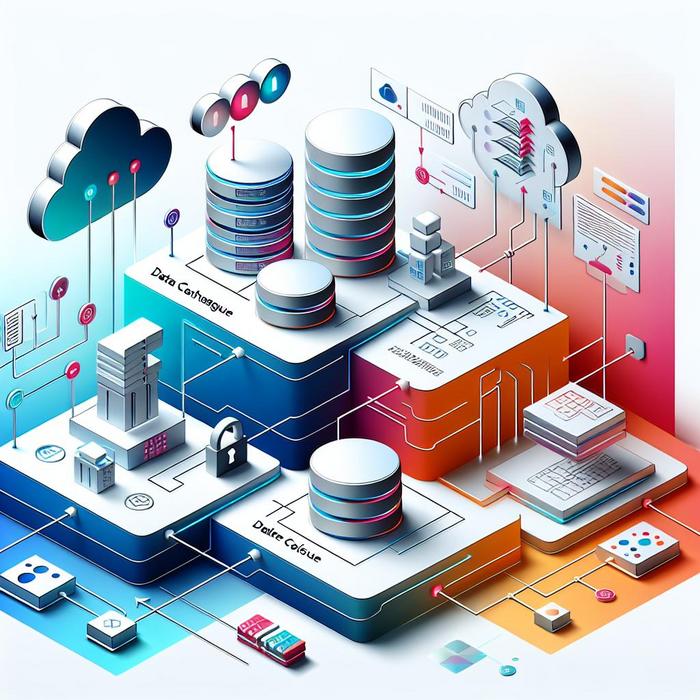Table of Contents Hide
Understanding the Core of Data Catalogues
 5 MIN. READING
5 MIN. READING
Why is a Data Catalogue Integral?
Do you ever wonder about the backbone that keeps data operations running smoothly and efficiently in large corporations? The answer lies in a comprehensive data catalogue, acting as the lifeblood of data management. But what is a data catalogue, and why is it so influential?
A data catalogue is an organized inventory of data assets in an organization. It aids in understanding data sources better and accelerates analytics. But more crucially, data catalogues can bring a radical shift in the efficiency of database virtualization and data anonymization, two formidable pillars amplifying data operations’ effectiveness.
The Symbiosis of Database Virtualization and Data Catalogues
For those savvy in IT leadership roles, the prospects of database virtualization with data catalogues unveil exciting opportunities. Creating a virtual data layer for unified access, database virtualization enables lightning-fast data provisioning, reducing time spent in testing, development, and analytics. Seamlessly integrated with a data catalogue, it simplifies data availability, security, and administration.
Data Anonymization: A Fine Balance of Utility and Privacy
With data being the new oil, data privacy regulations have become increasingly stringent. However, complying with these regulations doesn’t have to compromise the operational efficiency of your firm. Data anonymization techniques, when rightly implemented, mask sensitive information while retaining the data’s utility.
For instance, our in-depth guide on decoding data masking techniques provides insights into achieving this balance, while our article on mastering data privacy regulations takes you through the changing landscape of laws in the data realm.
Choosing the Right Data Management Platform
Choosing a suitable data management platform is crucial for CIOs, CTOs, data architects, and database administrators. The platform should be robust, offer comprehensive features, and align with your strategic goals.
When comparing platforms, the following are some key factors to consider:
- Seamless Integration: The platform should integrate smoothly with your existing IT infrastructure.
- Scalability: With dynamic business needs, the platform should scale up (or down) as per your requirements.
- Usability: The platform should be user-friendly, facilitating easy navigation and swift operations.
- Support: Timely and effective customer support is a must-have feature.
Where data-driven decisions hold foreseeable implications in strategic planning, understanding the core of data catalogues, and their interplay with database virtualization and data anonymization is no less than a game-changer. This knowledge empowers professionals to leverage optimal strategies, cutting-edge tools, and innovative approaches for managing data effectively.
As the data landscape continues to evolve, ensuring your understanding of these critical components is up-to-date is vital. Exploring the data catalog on data.gov and our piece on optimizing test data for mobile applications will further enhance your understanding and equip you to champion the data operations realm confidently.
Delving Deeper into Database Virtualization
Have you considered the advantages a data catalogue brings to database virtualization? Database virtualization is a method that provides a unified, abstracted, and real-time view of distributed, heterogeneous data sources. Adopting database virtualization translates into swift decision-making through quick access to crucial data across different sources in an organization.
Integrating a data catalogue with database virtualization is like merging two powerhouses. The former improves data discoverability while the latter enhances data portability in disparate structures, reducing bottlenecks, and ensuring quicker time-to-market. An efficient unified data catalog increases the viability of database virtualization, driving overall data management efficiency.
Data Anonymization: Ensuring Compliance and Utility
At the intersection of data utilization and time-sensitive regulations, the idea of data anonymization comes to the forefront. Data anonymization is the process of transforming data to maintain its usefulness while protecting sensitive information. It adds value by ensuring regulatory compliance, such as HIPAA, PCI DSS, and GDPR.
Equally important is the role data anonymization plays in maintaining users’ trust, a critical aspect for any industry. An effectively implemented data catalogue, coupled with anonymization techniques, is an amalgamation that fosters trust while amplifying business potential.
Unmasking the Strategically Essential Data Management Platform
CIOs, CTOs, data architects, and database administrators are continuously on the lookout for a data management platform that strikes the right chord between their business ambitions and data strategies. A fitting platform can be a game changer that seamlessly aligns with an organization’s data vision, accelerated innovation, and ensured compliance. But how can these professionals make the right pick?
– Data Governance: A fitting data management platform emphasises data governance and ensures data integrity, quality, and protection. The presence a structured data governance helps align business goals with data management processes.
– Future-proofing: A sustainable platform anticipates future data trends and is ready to adapt accordingly, hence safeguarding investment in the long term.
– Innovation cycle: Platforms built with technology that supports rapid innovation cycles and technological advancements foster flexibility and competitiveness in the data arms race.
– Cost-effectiveness: A cost-effective platform amplifies resource utilization, significantly driving down total costs while achieving enhanced efficiency.
While steering the helm at their respective organisations, IT leaders need to remain proactive and agile to maximize value from their data operations—improving quality, reducing costs, and enhancing agility. Embracing an organized catalog of data assets alongside advanced strategies such as database virtualization and data anonymization provides a course to ensure better informed, data-driven decision-making.
In the grand scheme of data operations, understanding the synergistic capability of these strategies is crucial — a necessity rather than an option. Visiting this WHO health survey data catalog or this data glossary catalog will provide additional information on how global catalogs function. Further, reading our article on optimizing test data for insurance applications can expand your understanding, paving your path towards data management supremacy.


